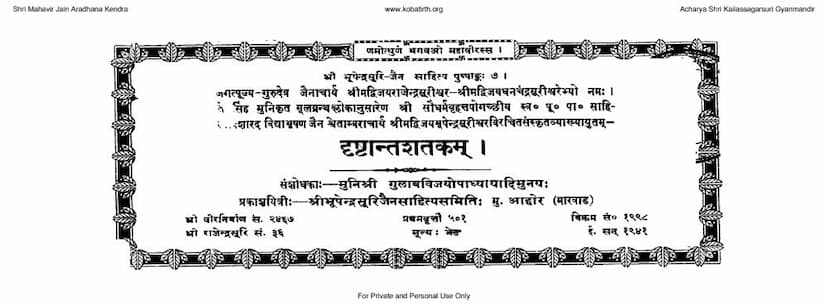Drushtant Shatakam
Added to library: September 1, 2025

Summary
This document is a Jain text titled Drushtant Shatakam (दृष्टान्तशतकम्), authored by Bhupendrasuri. It was published by Bhupendrasuri Jain Sahitya Samiti. The catalog link is provided as https://jainqq.org/explore/020322/1.
The text is a collection of 100 (shatakam) parables or illustrative stories (drushtant), presented in Sanskrit with a commentary (vyakhya) also in Sanskrit, likely explaining the moral or spiritual lessons behind each parable.
The provided pages indicate the following:
- Pages 1-3: These pages contain introductory material.
- Page 1 features a salutation to Lord Mahavir and spiritual preceptors like Acharya Shri Kailassagarsuri, Vijayrajendrasurishwar, and Vijaydhanchandrasurishwar. It mentions the author, Shree Vijaybhupendrasurishwar, and the Sanskrit commentary. It also lists the editors (Munishri Gulabvijayopadhyaya and others) and the publisher. The publication details include the era (Shri Veer Nirvana Samvat 2467, Vikram Samvat 1998, Shri Rajendrabhi Samvat 36), the year 1941 CE, and the fact that it's the first edition with 501 copies.
- Page 2 lists other books published by the Shree Bhupendrasuri Jain Sahitya Samiti, including "Suktamuktamali," "Jineendra Gunamanjari," "Shree Bhupendra Suri Jayanti," "Jagvallab Hastavamala," "Sindhur Prakar," and "Shant Sudharas Bhavana."
- Page 3 contains a "Do Shabda" (Two Words) section, likely an introduction from the publishing committee. It highlights that this is the 7th publication in the series of works by the late Acharya Shree Vijaybhupendrasurishwar. It mentions the establishment of the "Shree Bhupendrasuri Jain Sahitya Samiti" in 1995 VS to publish his works and lists the monks appointed for this task.
- Pages 5 onwards: These pages begin the main body of the text, presenting the parables.
- Page 5: Contains the mangalacharan (auspicious invocation) by the author, dedicated to Rishabhdev, the first Tirthankara.
- Page 6: Presents the mangalacharan of the commentator, dedicated to Lord Mahavir and Guru Rajendrasuri. It then introduces the first parable, illustrating the transient nature of worldly pleasures using the metaphor of a honey drop. The parable involves a person trapped between a wild elephant, snakes in a well, rats gnawing at a root, and bees dripping honey.
- Page 8: Introduces the second parable, which uses the story of blind men touching different parts of an elephant to illustrate the limitations of one-sided or exclusive viewpoints (ekantavada) in understanding reality, contrasting it with the anekantavada of Jainism.
- Subsequent pages (9-93): Continue with a series of parables, each numbered sequentially. The text provides the story and often a short commentary or interpretation. Some of the topics and parables covered include:
- The consequence of actions (like the thief parable).
- The importance of quick-wittedness.
- The nature of wisdom and folly.
- The effects of association (good and bad).
- The inevitability of fate and karma.
- The consequences of greed and attachment.
- The importance of rightful actions and avoiding disputes.
- The value of knowledge and discernment.
- The nature of true devotion and the importance of right belief.
- The consequences of foolish advice and actions.
- The nature of righteous conduct and the dangers of unrighteousness.
- The impact of speech and avoiding harsh words.
- The importance of understanding the correct context and timing for actions.
- The superiority of non-violence and compassion.
- The futility of trying to please everyone.
- The consequences of not valuing one's own possessions.
- The importance of choosing good company.
- The nature of karma and its fruit.
- The dangers of attachment to worldly possessions.
- The importance of proper upbringing and education.
- The consequences of misjudging others.
- The dangers of ill-timed actions or speech.
- The importance of righteous conduct.
- The true meaning of generosity and compassion.
- The importance of understanding the true nature of things.
- The futility of misplaced efforts and the importance of timely action.
- The value of wisdom and discernment.
- The importance of understanding and following correct teachings.
- The consequences of misguided devotion and attachment.
- The dangers of anger and the benefits of restraint.
- The futility of clinging to worldly things.
- The importance of purity and detachment.
- The consequences of pride and arrogance.
- The importance of righteousness and justice.
- The importance of proper guidance and the dangers of following the wrong path.
- The value of true devotion over rituals.
- The consequences of attachment and the pursuit of worldly pleasures.
- The importance of good conduct and the dangers of associating with the wrong people.
- The importance of understanding one's own faults.
- The importance of true knowledge over mere rituals.
- The futility of seeking worldly gains through deceit.
- The value of righteous deeds.
- The importance of compassion and the rejection of violence.
- The consequences of attachment to wealth and the importance of true renunciation.
- The dangers of blind adherence to customs.
- The importance of critical thinking and understanding.
- The value of a wise mind and the dangers of folly.
- The importance of good conduct and the avoidance of the six types of violence (shad-kaya hinsa).
- The importance of supporting good causes and avoiding bad ones.
- The consequences of asking questions at the wrong time.
- The importance of controlling the mind.
- The understanding of cause and effect in actions.
- The value of good deeds and the detrimental nature of harmful actions.
- The importance of renunciation and spiritual practice.
- The consequences of pride and self-deception.
- The importance of discerning between right and wrong.
- The value of following the teachings of the Tirthankaras.
- The importance of protecting all living beings.
In essence, Drushtant Shatakam is a didactic work, utilizing a collection of stories to impart moral and ethical lessons rooted in Jain philosophy, emphasizing virtues like non-violence, detachment, right belief and conduct, wisdom, and the consequences of negative traits like greed, anger, and ignorance. The Sanskrit commentary likely elucidates the deeper spiritual and philosophical meanings within each narrative.